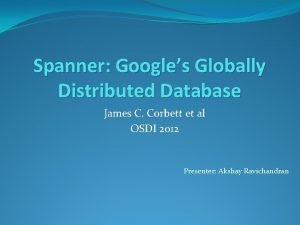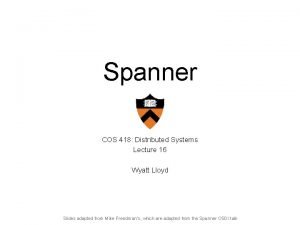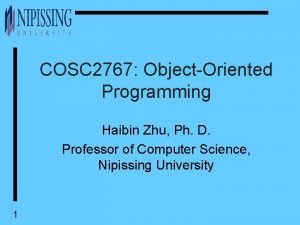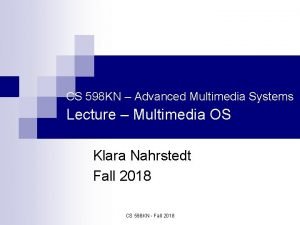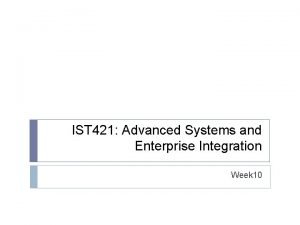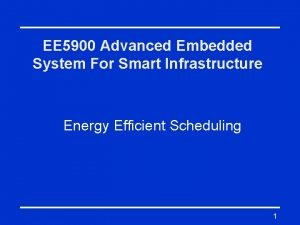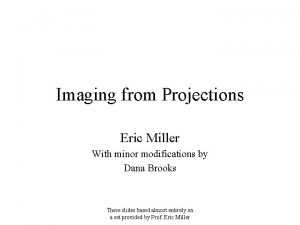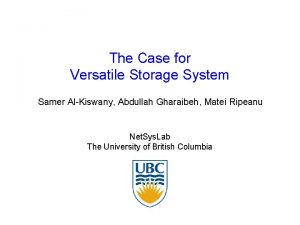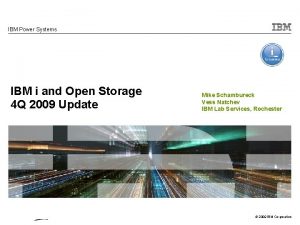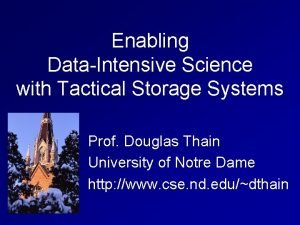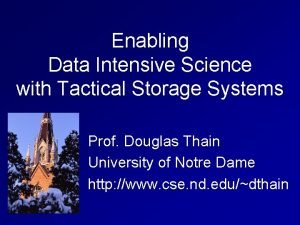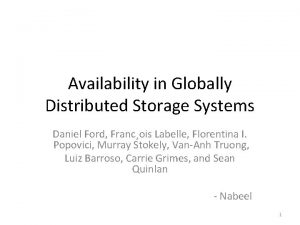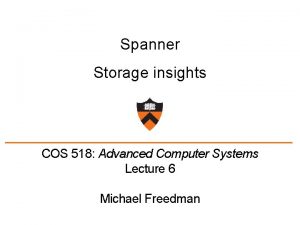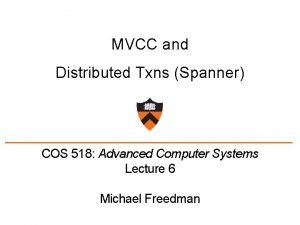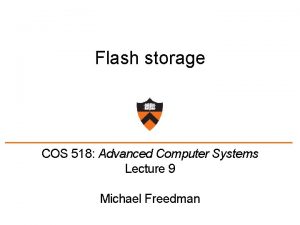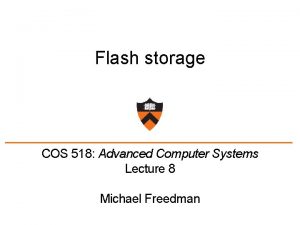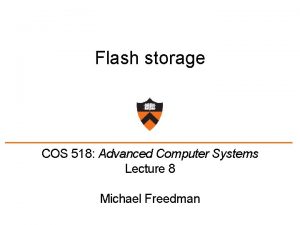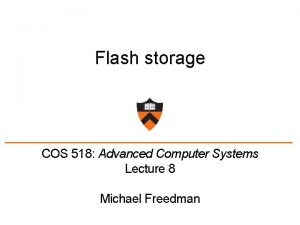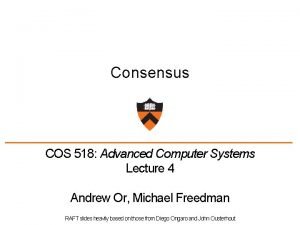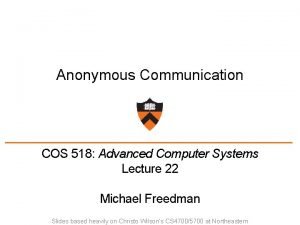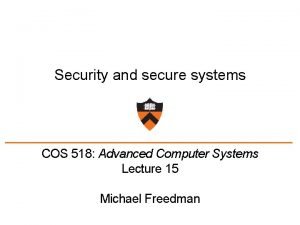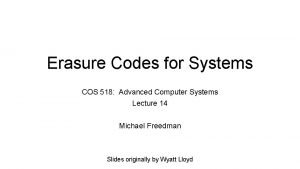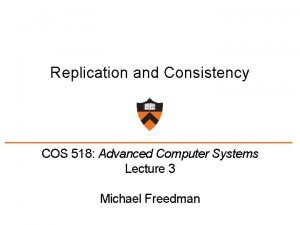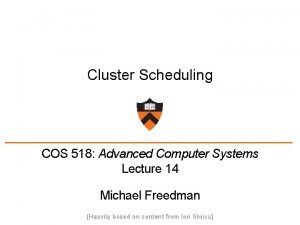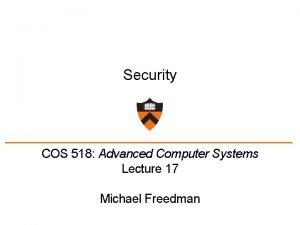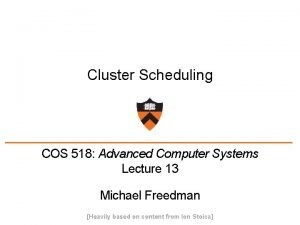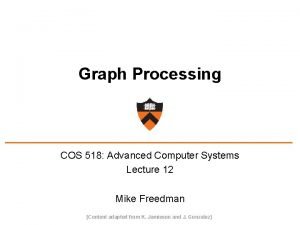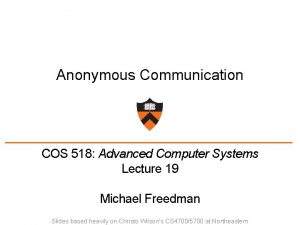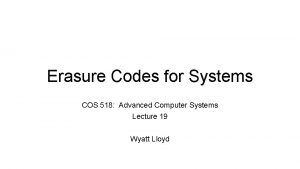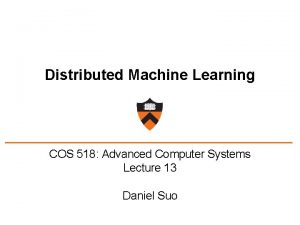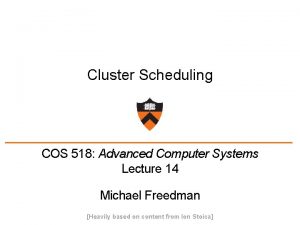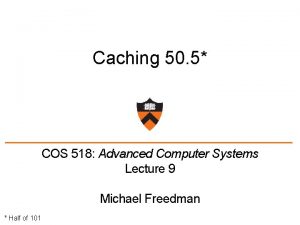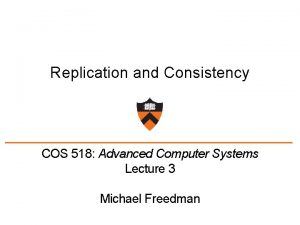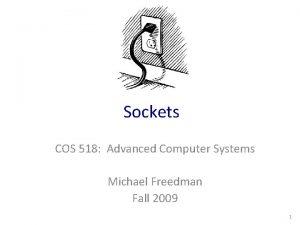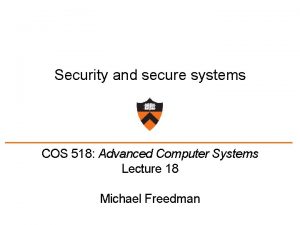Spanner Storage insights COS 518 Advanced Computer Systems
































- Slides: 32

Spanner Storage insights COS 518: Advanced Computer Systems Lecture 6 Michael Freedman

2 PL & OCC = strict serialization • Provides semantics as if only one transaction was running on DB at time, in serial order + Real-time guarantees • 2 PL: Pessimistically get all the locks first • OCC: Optimistically create copies, but then recheck all read + written items before commit 2

Multi-version concurrency control Generalize use of multiple versions of objects 3

Multi-version concurrency control • Maintain multiple versions of objects, each with own timestamp. Allocate correct version to reads. • Prior example of MVCC: 4

Multi-version concurrency control • Maintain multiple versions of objects, each with own timestamp. Allocate correct version to reads. • Unlike 2 PL/OCC, reads never rejected • Occasionally run garbage collection to clean up 5

MVCC Intuition • Split transaction into read set and write set – All reads execute as if one “snapshot” – All writes execute as if one later “snapshot” • Yields snapshot isolation < serializability 6

Serializability vs. Snapshot isolation • Intuition: Bag of marbles: ½ white, ½ black • Transactions: – T 1: Change all white marbles to black marbles – T 2: Change all black marbles to white marbles • Serializability (2 PL, OCC) – T 1 → T 2 or T 2 → T 1 – In either case, bag is either ALL white or ALL black • Snapshot isolation (MVCC) – T 1 → T 2 or T 2 → T 1 or T 1 || T 2 – Bag is ALL white, ALL black, or ½ white ½ black 7

Distributed Transactions 18

Consider partitioned data over servers O P L R L Q U R W U L W U • Why not just use 2 PL? – Grab locks over entire read and write set – Perform writes – Release locks (at commit time) 19

Consider partitioned data over servers O P Q L R L U R W U L W U • How do you get serializability? – On single machine, single COMMIT op in the WAL – In distributed setting, assign global timestamp to txn (at sometime after lock acquisition and before commit) • Centralized txn manager • Distributed consensus on timestamp (not all ops) 20

Strawman: Consensus per txn group? O P Q L R L U R W U L W U R S • Single Lamport clock, consensus per group? – Linearizability composes! – But doesn’t solve concurrent, non-overlapping txn problem 21

Spanner: Google’s Globally. Distributed Database OSDI 2012 22

Google’s Setting • Dozens of zones (datacenters) • Per zone, 100 -1000 s of servers • Per server, 100 -1000 partitions (tablets) • Every tablet replicated for fault-tolerance (e. g. , 5 x) 23

Scale-out vs. fault tolerance O O O P P P Q Q Q • Every tablet replicated via Paxos (with leader election) • So every “operation” within transactions across tablets actually a replicated operation within Paxos RSM • Paxos groups can stretch across datacenters! – (COPS took same approach within datacenter) 24

Disruptive idea: Do clocks really need to be unsynchronized? arbitrarily Can you engineer some max divergence? 25

True. Time • “Global wall-clock time” with bounded uncertainty TT. now() earliest time latest 2*ε Consider event enow which invoked tt = TT. new(): Guarantee: tt. earliest <= tabs(enow) <= tt. latest 26

Timestamps and True. Time Acquired locks Release locks T Pick s > TT. now(). latest s Wait until TT. now(). earliest > s Commit wait average ε 27

Commit Wait and Replication Start consensus Acquired locks Achieve Notify consensus followers Release locks T Pick s Commit wait done 28

Client-driven transactions Client: 1. Issues reads to leader of each tablet group, which acquires read locks and returns most recent data 2. Locally performs writes 3. Chooses coordinator from set of leaders, initiates commit 4. Sends commit message to each leader, include identify of coordinator and buffered writes 5. Waits for commit from coordinator 29

Commit Wait and 2 -Phase Commit • On commit msg from client, leaders acquire local write locks – If non-coordinator: • Choose prepare ts > previous local timestamps • Log prepare record through Paxos • Notify coordinator of prepare timestamp – If coordinator: • • • Wait until hear from other participants Choose commit timestamp >= prepare ts, > local ts Logs commit record through Paxos Wait commit-wait period Sends commit timestamp to replicas, other leaders, client • All apply at commit timestamp and release locks 30

Commit Wait and 2 -Phase Commit Start logging Done logging Acquired locks Release locks TC Committed Notify participants sc Release locks Acquired locks TP 1 Release locks Acquired locks TP 2 Compute sp for each Prepared Send sp Commit wait done Compute overall sc 31

Example Remove X from friend list Risky post P TC T 2 sp = 6 TP sc = 8 s = 15 Remove myself from X’s friend list sp = 8 sc = 8 Time <8 8 My friends My posts X’s friends [X] [] 15 [P] [me] [] 32

Read-only optimizations • Given global timestamp, can implement read-only transactions lock-free (snapshot isolation) • Step 1: Choose timestamp sread = TT. now. latest() • Step 2: Snapshot read (at sread) to each tablet – Can be served by any up-to-date replica 33

Disruptive idea: Do clocks really need to be unsynchronized? arbitrarily Can you engineer some max divergence? 34

True. Time Architecture GPS timemaster Atomic-clock timemaster GPS timemaster Client Datacenter 1 Datacenter 2 … Datacenter n Compute reference [earliest, latest] = now ± ε 35

True. Time implementation now ε = reference now + local-clock offset = reference ε = 1 ms + worst-case local-clock drift + 200 μs/sec ε +6 ms 0 sec 30 sec 60 sec 90 sec time • What about faulty clocks? – Bad CPUs 6 x more likely in 1 year of empirical data 36

Known unknowns > unknowns Rethink algorithms to reason about uncertainty 37

The case for log storage: Hardware tech affecting software design 38

Latency Numbers Every Programmer Should Know June 7, 2012 From https: //gist. github. com/jboner/2841832 See also https: //people. eecs. berkeley. edu/~rcs/research/interactive_latency. html 39

~2016 Seagate ($50) 1 TB HDD 7200 RPM Model: STD 1000 DM 003 -1 SB 10 C Operation HDD Performance Sequential Read 176 MB/s Sequential Write 190 MB/s Random Read 4 Ki. B 0. 495 MB/s 121 IOPS Random Write 4 Ki. B 0. 919 MB/s 224 IOPS DQ Random Read 4 Ki. B 1. 198 MB/s 292 IOPS DQ Random Write 4 Ki. B 0. 929 MB/s 227 IOPS http: //www. tomshardware. com/answers/id-3201572/good-normal-read-write-speed-hdd. html 40

~2016 Operation Seagate ($50) 1 TB HDD 7200 RPM 512 GB 960 Pro NVMe PCIe M. 2 Model: STD 1000 DM 003 -1 SB 10 C Model: MZ-V 6 P 512 BW HDD Performance Samsung ($330) SSD Performance Sequential Read 176 MB/s 2268 MB/s Sequential Write 190 MB/s 1696 MB/s Random Read 4 Ki. B 0. 495 MB/s 121 IOPS 44. 9 MB/s 10, 962 IOPS Random Write 4 Ki. B 0. 919 MB/s 224 IOPS 151 MB/s 36, 865 IOPS DQ Random Read 4 Ki. B 1. 198 MB/s 292 IOPS 348 MB/s 84961 IOPS DQ Random Write 4 Ki. B 0. 929 MB/s 227 IOPS 399 MB/s 97, 412 IOPS http: //www. tomshardware. com/answers/id-3201572/good-normal-read-write-speed-hdd. html http: //ssd. userbenchmark. com/Speed. Test/182182/Samsung-SSD-960 -PRO-512 GB 41

• Idea: Traditionally disks laid out with spatial locality due to cost of seeks • Observation: main memory getting bigger → most reads from memory • Implication: Disk workloads now write-heavy → avoid seeks → write log • New problem: Many seeks to read, need to occasionally defragment • New tech solution: SSDs → seeks cheap, erase blocks change defrag 42
 Opwekking 694 tekst
Opwekking 694 tekst Google spanner
Google spanner Thomas spanner
Thomas spanner Spanner cap theorem
Spanner cap theorem Graph spanner
Graph spanner Transferring of data from auxiliary storage to main storage
Transferring of data from auxiliary storage to main storage Storage devices of computer
Storage devices of computer Uses rigid metallic platters
Uses rigid metallic platters Unified storage vs traditional storage
Unified storage vs traditional storage Diketahui sin a = 0,6 dan a sudut lancip adalah
Diketahui sin a = 0,6 dan a sudut lancip adalah Cos c -cos d formula
Cos c -cos d formula Sin 160° + sin 40°
Sin 160° + sin 40° Sen a cos b sen b cos a
Sen a cos b sen b cos a Intreccio narrativo
Intreccio narrativo Elementi fondamentali della narrazione
Elementi fondamentali della narrazione What quadrants can inverse cosine be in
What quadrants can inverse cosine be in Nilai sin 22 5° adalah
Nilai sin 22 5° adalah Tentukan nilai perbandingan trigonometri sin 315 derajat
Tentukan nilai perbandingan trigonometri sin 315 derajat Advanced fusion systems llc
Advanced fusion systems llc Advanced fueling systems
Advanced fueling systems Advanced multimedia systems
Advanced multimedia systems Advanced fluid systems inc
Advanced fluid systems inc Tom kilcer advanced ag systems
Tom kilcer advanced ag systems Ist 421
Ist 421 Advanced embedded systems
Advanced embedded systems Enotes fst
Enotes fst Advanced cooling systems inc
Advanced cooling systems inc Samer al-kiswany
Samer al-kiswany Storage for ibm power systems
Storage for ibm power systems Tactical storage systems
Tactical storage systems Tactical storage systems
Tactical storage systems Availability in globally distributed storage systems
Availability in globally distributed storage systems Review of fundamentals of cpu
Review of fundamentals of cpu

